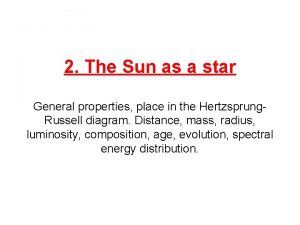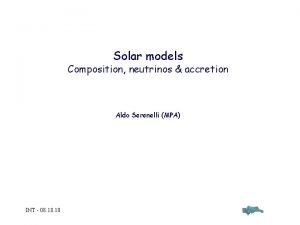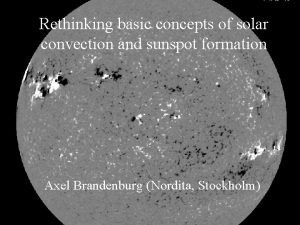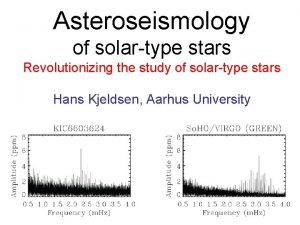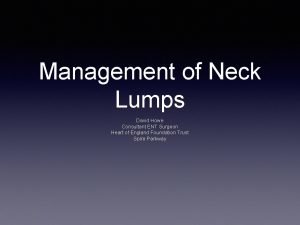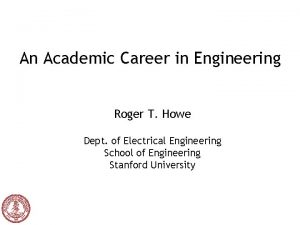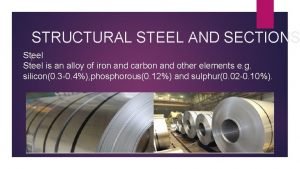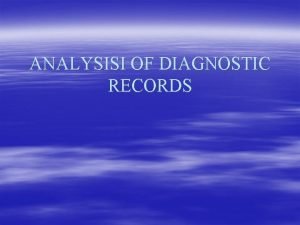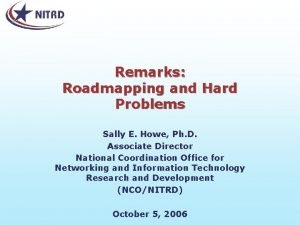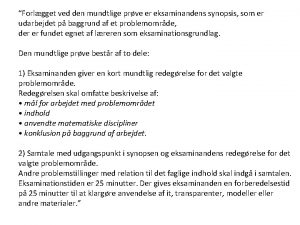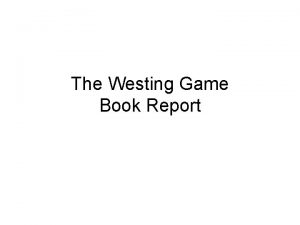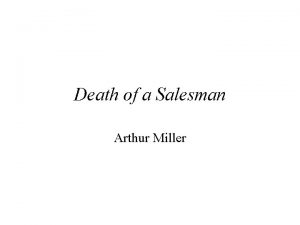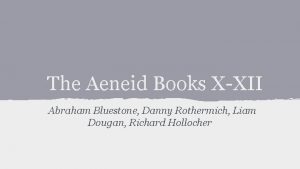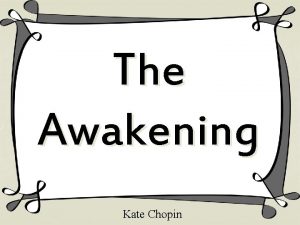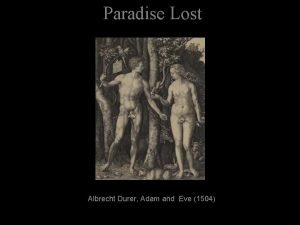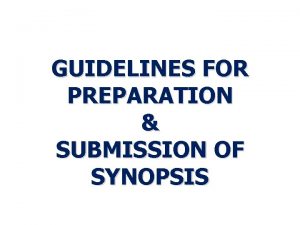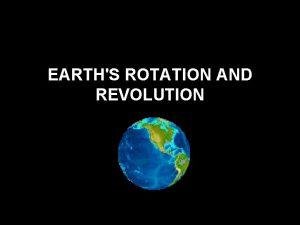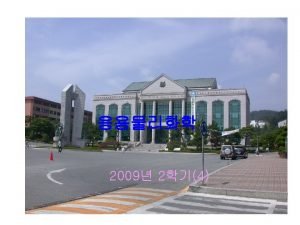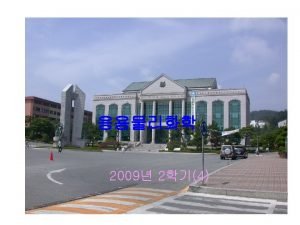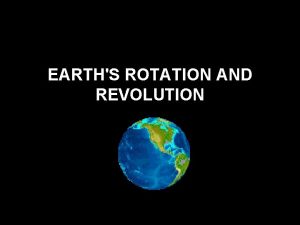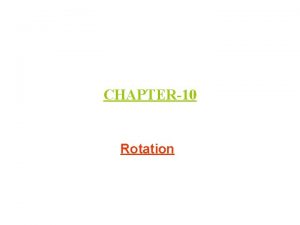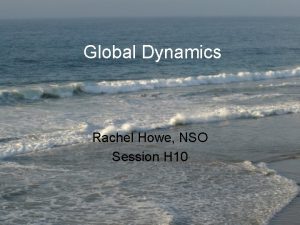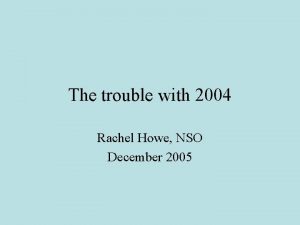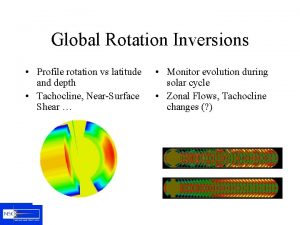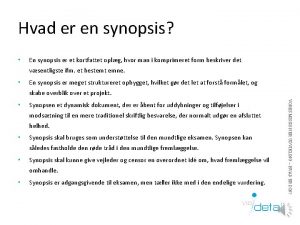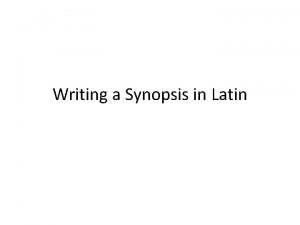HELIOSEISMOLOGY RESULTS Rachel Howe Synopsis Rotation profile Rotation



































- Slides: 35

HELIOSEISMOLOGY: RESULTS Rachel Howe

Synopsis � � Rotation profile Rotation changes over the solar cycle � The torsional oscillation � Tachocline fluctuations � Frequency and parameter changes � Global frequency shifts � Local frequency shifts � Looking for interior changes

Solar Rotation Profile

Convection-Zone Dynamics � � � So-called ‘torsional oscillation’ is a pattern of weak slower and faster zonal flows migrating from midlatitudes to the equator and poles over the solar cycle. First observed by Howard and Labonte (1980) in surface observations Surface Doppler measurements from Mt Wilson go back to 1986. (Ulrich 2001).

Helioseismic Detection of the Torsional Oscillation � � Seen in 4 years of GONG and 3 years of MDI data by Toomre et al. (2000), Howe, Komm & Hill (2000), Howe et al. (2000) Penetration depth at least 0. 92 R.

Torsional Oscillation � Vorontsov et al (2003) showed that the phenomenon involves much of convection zone, and analyzed the signal in terms of 11 year sinusoidal variations.

Zonal Flow Patterns (Time-Radius) 0 MDI OLA MDI RLS GONG RLS Howe et al 2005 15 30 45 60

Comparison of near-surface flow observations MDI GLOBAL DOPPLER MDI LOCAL Howe et al, 2006

Slow start to Cycle 24 Howe et al. 2009

Delayed ending of Cycle 23

High-latitude Residuals

Zonal Flows -- Summary � � Torsional oscillation pattern involves most of convection zone Related to timing of solar cycle Strength may not be related to cycle strength High-latitude flows show this cycle is not like the last one (or maybe the one before that. )

Variations at the Tachocline See Howe et al. (2000; Science 287, 2456)

Tachocline oscillations Basu & Antia (2001; MNRAS 324, 498)

Frequency Shifts � � Rule 1: Everything varies with everything else Rule 2: It’s always more complicated Well established that p-mode frequency increases with solar activity Response to activity increases with activity (until it starts decreasing again. )

Sound-Speed Inversion � � � Differences from model are tiny. Anomaly at base of convection zone – heavy element settling? But things look worse with more recent opacity values.

Frequency shifts with solar cycle � ACRIM (Woodard & Noyes 1985, 1988, Gelly, Fossat & Grec 1988) � Bi. SON, Mark I (Palle et al. 1989, Elsworth et al. 1990) Chaplin et al. 2007

Frequency shifts with solar cycle

l=50, n=10 variation Slight systematic shift between MDI and GONG

Frequency shift sensitivity to B Howe et al. 2002

Even splitting coefficients follow magnetic activity distribution in latitude (Antia et al 2001, Howe et al 2002)

Localized Global Frequency Shifts (Howe, Komm & Hill 2002)

High-degree Frequency Shifts � � � Mode frequencies are higher in active regions (Hindman et al, 2000). Also, amplitude decreases and linewidth increases.

Ring-diagram frequency sensitivity (HMI) � � Method-dependent Also depends on position on disk (or detector)

Time-Distance – Results � Sound speed and flow patterns below a sunspot

Structure inversions under active regions – ring diagrams � Bogart et al. 2008, Sol. Phys.

� � � Frequency shifts correlate with surface flux in time and space, at a wide range of scales BUT remember Rule 2: It’s always more complicated Is there interesting information in the deviations from the trends?

Different short-term sensitivity in different years? From Tripathy et al. , 2007 Solar Phys. 243, 105

Fluctuations in Frequency Residuals Broomhall et al. 2011

Search for Subsurface Structure � � Frequency shifts are strongly correlated with surface activity, but such changes are mostly shallow. Finding subsurface changes in structure (sound speed/density) requires careful removal of surface effects

Subsurface Structure Changes? � Basu & Mandel (2004), Verner, Chaplin & Elsworth (2006) – evidence for solar-cycle change in amplitude of He ionization zone signature (0. 98 R) from GONG, MDI, Bi. SON data.

Search for Structural Change � Eff-Darwich et al 2002 – upper limit of 3 e-5 on stratification change at base of convection zone

Subsurface Structure Changes � Chou & Serebryanskiy 2005, Serbryanskiy & Chou 2005 – possible wave speed change near bottom of convection zone.

Sound speed changes at the base of the convection zone � � Baldner & Basu, 2008 l ≤ 176, 2 ≤ n ≤ 16 Principal Component Analysis Interior changes at latitudes below 45 deg.

Conclusions � � Helioseismology reveals changes in dynamics deep in the convection zone. Improved knowledge of convection-zone dynamics may help predict future cycles. Solar activity at the surface influences mode parameters. Detection of interior structural change is still difficult.
 Helioseismology
Helioseismology Helioseismology
Helioseismology Helioseismology
Helioseismology Helioseismology
Helioseismology Helioseismology
Helioseismology Difference between racemic mixture and meso compound
Difference between racemic mixture and meso compound Geoffrey howe resignation speech youtube
Geoffrey howe resignation speech youtube Template
Template Ostrov lorda howe
Ostrov lorda howe Roger t. howe
Roger t. howe L-shaped roof truss layout
L-shaped roof truss layout Compound fink truss
Compound fink truss Bolton's analysis inference
Bolton's analysis inference Adina howe
Adina howe James howe the misfits
James howe the misfits Howe scale identification
Howe scale identification Bill howe uw
Bill howe uw Matematik synopsis
Matematik synopsis Why is blanche always bathing
Why is blanche always bathing Forrest gump summary movie
Forrest gump summary movie Problemformulering skabelon
Problemformulering skabelon 17 aurelianos
17 aurelianos Hansel and gretel opera synopsis
Hansel and gretel opera synopsis Westing game synopsis
Westing game synopsis Overflow chapter 7
Overflow chapter 7 Death of a salesman interpretation
Death of a salesman interpretation Pengantar visualisasi konsep
Pengantar visualisasi konsep Hamlet themes
Hamlet themes Aeneid synopsis
Aeneid synopsis Den videnskabelige basismodel
Den videnskabelige basismodel What is a synopsis
What is a synopsis Summary of the black cat edgar allan poe
Summary of the black cat edgar allan poe The awakening synopsis
The awakening synopsis Freedom writers criticism
Freedom writers criticism Flowers for algernon story
Flowers for algernon story Paradise lost synopsis
Paradise lost synopsis

